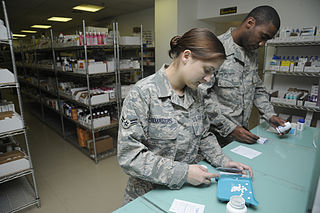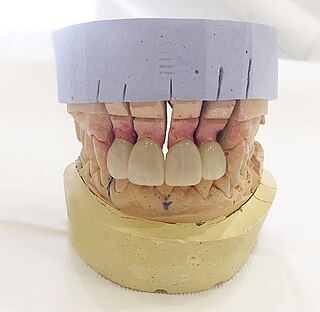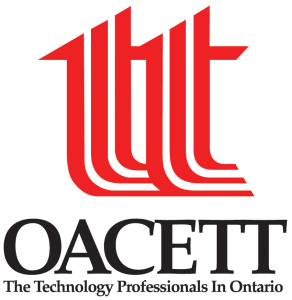Professional certification, trade certification, or professional designation, often called simply certification or qualification, is a designation earned by a person to assure qualification to perform a job or task. Not all certifications that use post-nominal letters are an acknowledgement of educational achievement, or an agency appointed to safeguard the public interest.

Phlebotomy is the process of making a puncture in a vein, usually in the arm, with a cannula for the purpose of drawing blood. The procedure itself is known as a venipuncture, which is also used for intravenous therapy. A person who performs a phlebotomy is called a phlebotomist, although most doctors, nurses, and other technicians can also carry out a phlebotomy. In contrast, phlebectomy is the removal of a vein.

An engineering technologist is a professional trained in certain aspects of development and implementation of a respective area of technology. Engineering technology education is even more applied and less theoretical than engineering education, though in a broad sense both have a focus on practical application. Engineering technologists often assist engineers but after years of experience, they can also become engineers. Like engineers, areas where engineering technologists can work include product design, fabrication and testing. Also as with engineers, engineering technologists sometimes rise to senior management positions in industry or become entrepreneurs.

A pharmacy technician performs pharmacy-related functions, working collaboratively with a licensed pharmacist. Training, certification, licensing, and actual practice of pharmacy technicians varies not only worldwide but in some countries regionally as well as by employer.

A surgical technologist, also called a scrub, scrub tech, surgical technician, or operating room technician, is an allied health professional working as a part of the team delivering surgical care. Surgical technologists are members of the surgical team. The members of the team include the surgeon, surgeon's assistant, circulator nurse and anesthesia provider. They possess knowledge and skills in sterile and aseptic techniques. There are few mandatory professional requirements for surgical technologists, and the scope of practice varies widely across countries and jurisdictions. Surgical technologists attend junior colleges and technical schools, and many are trained in military schools. In the military they perform the duties of both the circulator and the scrub. The goal is for surgical technologists to be able to anticipate the next move the surgeon is going to make in order to make the procedure as smooth and efficient as possible. They do this by having knowledge of hundreds of surgical procedures and the steps the surgeon needs to take in order to complete the procedure, including the very wide range of surgical instruments they may need. Specialties can include, but are not limited to, the following: genitourinary, obstetrics and gynaecology, urology, ENT, plastics, general, orthopedics, neurology, and cardiovascular. They only work in surgical or perioperative areas and are highly specialized. Surgical technologist is the proper term for a two-year program which earns a degree in applied sciences. The profession is up and coming and highly in demand.
A medical assistant, also known as a "clinical assistant" or healthcare assistant in the USA is an allied health professional who supports the work of physicians, nurse practitioners, physician assistants and other health professionals, usually in a clinic setting. Medical assistants can become certified through an accredited program. Medical assistants perform routine tasks and procedures in a medical clinic.

A medical laboratory scientist (MLS) or clinical laboratory scientist (CLS) or medical technologist (MT) performs diagnostic testing of blood and body fluids in clinical laboratories. The scope of a medical laboratory scientist's work begins with the receipt of patient or client specimens and terminates with the delivery of test results to physicians and other healthcare providers. The utility of clinical diagnostic testing relies squarely on the validity of test methodology. To this end, much of the work done by medical laboratory scientists involves ensuring specimen quality, interpreting test results, data-logging, testing control products, performing calibration, maintenance, validation, and troubleshooting of instrumentation as well as performing statistical analyses to verify the accuracy and repeatability of testing. Medical laboratory scientists may also assist healthcare providers with test selection and specimen collection and are responsible for prompt verbal delivery of critical lab results. Medical Laboratory Scientist in health settings also play an important role in the diagnosis of diseses conditions. An estimated 70% of medical decisions are based on laboratory test results and MLS contributions affect 95% of a health system's costs.
Certified Engineering Technologist is a Canadian professional title awarded on the basis of academic qualification and work experience. Abbreviated as C.E.T., most Canadian provincial engineering and applied science technology associations offer this certification. Certification is voluntary and does not represent a provincial regulatory requirement or a statutory required license.
The National Institute for Certification in Engineering Technologies (NICET) is an organization that was established in 1961 to create a recognized certification for engineering technicians and technologists within the United States. A 1981 study by the National Cooperative Highway Research Program (NCHRP), requested by the American Association of State Highway and Transportation Officials' SubCommittee On Construction, prompted the National Society of Professional Engineers (NSPE) to merge two certification bodies; the Institute for the Certification of Engineering Technicians (ICET) and the Engineering Technologist Certification Institute. The result is a nonprofit organization that provides a nationally recognized and accepted procedure for recognition of qualified engineering technicians and technologists.

Dental laboratories manufacture or customize a variety of products to assist in the provision of oral health care by a licensed dentist. These products include crowns, bridges, dentures and other dental products. Dental lab technicians follow a prescription from a licensed dentist when manufacturing these items, which include prosthetic devices and therapeutic devices. The FDA regulates these products as medical devices and they are therefore subject to FDA's good manufacturing practice ("GMP") and quality system ("QS") requirements. In most cases, however, they are exempt from manufacturer registration requirements. Some of the most common restorations manufactured include crowns, bridges, dentures, and dental implants. Dental implants is one of the most advanced dental technologies in the field of dentistry.
In the United States, anesthesia can be administered by physician anesthesiologists, an anesthesiologist assistant, or nurse anesthetist.

The Ontario Association of Certified Engineering Technicians and Technologists, or OACETT, is a not-for-profit, self-governing organization in Ontario, Canada. It is a professional association that promotes the interests of engineering and applied science technicians and technologists to industry, educational institutions, government and with the public. It currently has 24,000+ members.
National Board of Diving and Hyperbaric Medical Technology (NBDHMT), formally known as the National Association of Diving Technicians, is a non-profit organization devoted to the education and certification of qualified personnel in the fields of diving and hyperbaric medicine.
Certified Broadcast Technologist (CBT) is a title granted to an individual that successfully meets the experience or examination requirements of the certification. The certification is regulated by the Society of Broadcast Engineers (SBE). The CBT title is protected by copyright laws. Individuals who use the title without consent from the Society of Broadcast Engineers could face legal action.
Applied Science Technologist is a Canadian professional title awarded on the basis of academic qualification and work experience. Abbreviated as A.Sc.T., some, but not all, Canadian provincial engineering and applied science technology associations offer this certification.

The American Society of Anesthesia Technologists & Technicians, or ASATT, based in Oak Creek, Wisconsin, is a non-profit, educational organization responsible for the standards of technologist/technician competency in all areas of anesthesia.
Certified Anesthesia Technician (Cer.A.T.) is a title granted to an individual that successfully meets the experience and examination requirements of the certification. The certification is regulated by the American Society of Anesthesia Technologists & Technicians (ASATT).
A polysomnographic technologist performs overnight, daytime, or home sleep studies, polysomnograms, on people with suspected sleep disorders. In the United States and worldwide, the process for becoming a polysomnography technician or technologist is primarily either on-the-job or certificate based. There are associate level programs offered by for-profit schools that award a degree in polysomnography technology in the United States, though not necessary to attain employment with the same title. After an education program or adequate on-the-job training is complete, the student is eligible for credentialing by the Board of Registered Polysomnographic Technologists (BRPT), a non-profit credentialing agency based in the United States but serving polysomnographers worldwide. The BRPT maintains credentialing for over 35 countries including Canada and the United States as well as over 17,000 individuals working in the industry.
An autotransfusionist, also known as a perioperative blood management technologist, is a specialized allied health professional who operates the cell saver machine during surgeries that expect significant blood loss.
Ophthalmic technicians, also known as ophthalmic medical technicians, certified ophthalmic technicians (COT), or allied ophthalmic personnels, are skilled medical professionals who work alongside ophthalmologists to perform eye exams, diagnose diseases and administer treatments in caring for patients' eyes and eyesight. They are considered to be an intermediate level of ophthalmic medical personnel since they are more advanced than ophthalmic assistants, yet not as advanced as an ophthalmic medical technologist. Ophthalmic technicians work in settings like private practices, hospitals, outpatient care centers, and surgical centers.







